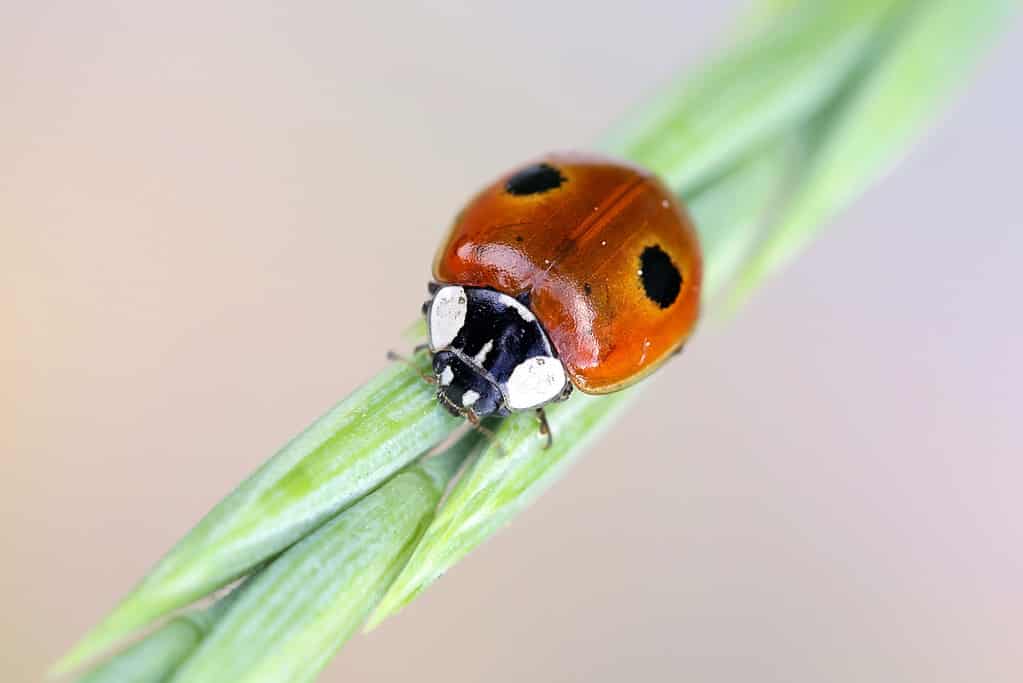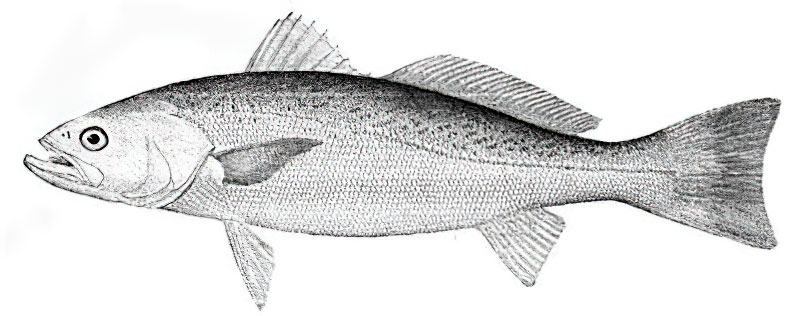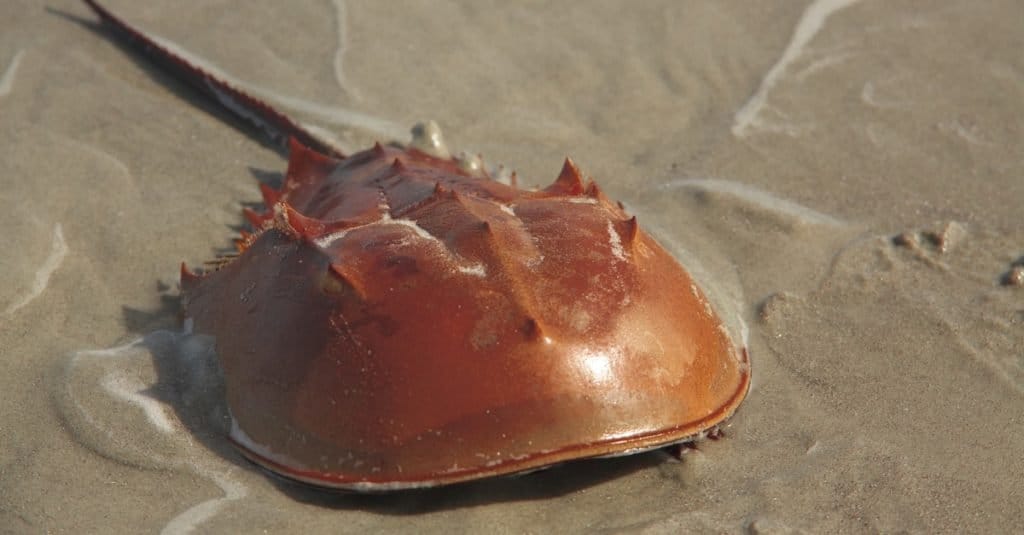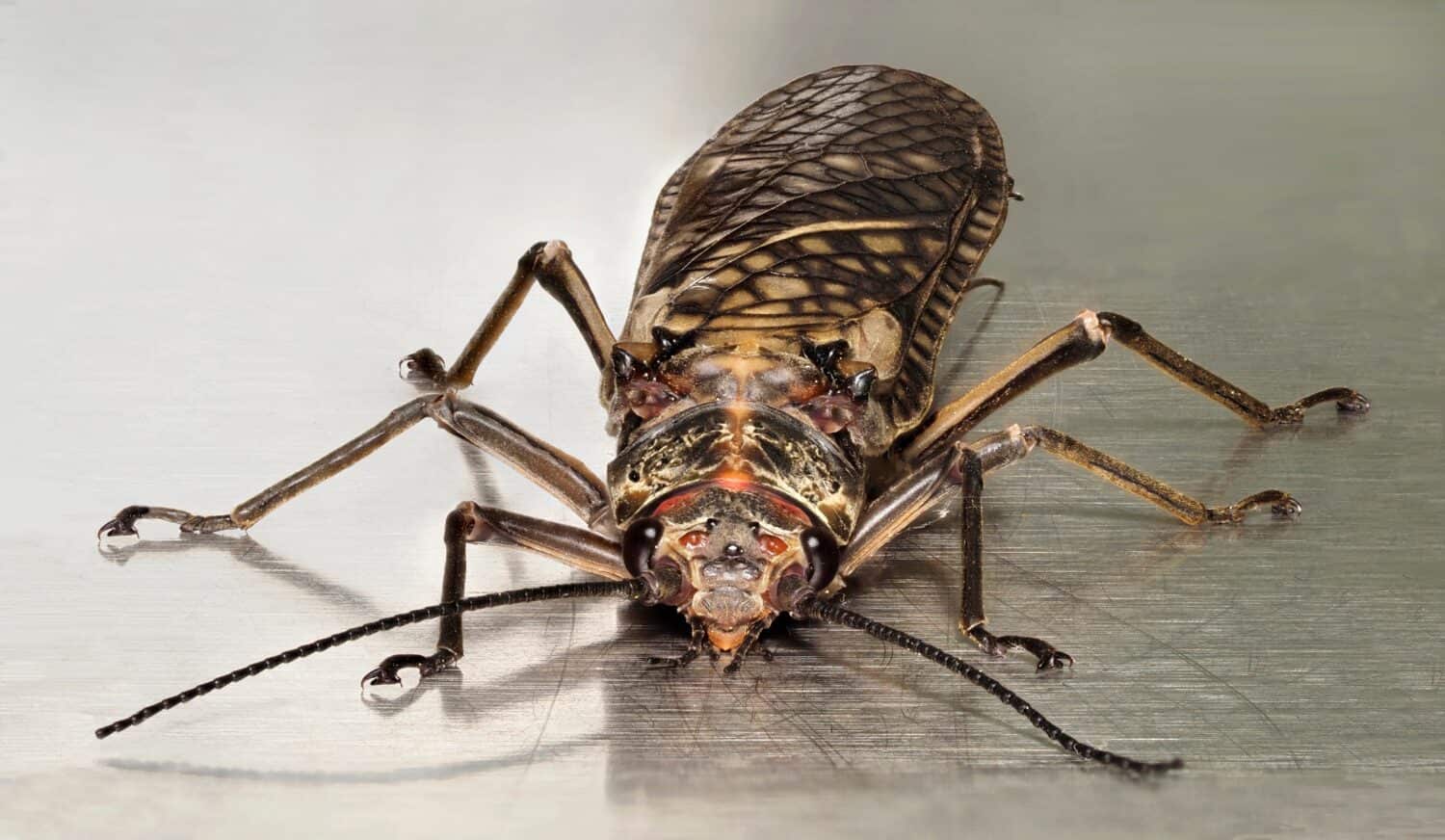
Every state chooses emblems as symbols of the state. These signify some of the characteristics that make the state particularly unique or that may be representative of the state’s geography or culture. Delaware has numerous symbols, which include a state seal, state flag, state colors, state flower, state tree, state beverage, and even state fossil. Among these are several official state animals. This article introduces you to the seven creatures that are the state animals of Delaware. These include the famed blue hen, ladybug, weakfish, tiger swallowtail butterfly, gray fox, horseshoe crab, and stonefly. Each one of these was specially chosen to signify some aspect of Delaware and its wildlife and was made official through an act by the state government. Let’s learn more about these seven special state animals of Delaware now!
State Bird: Blue Hen

Blue Andalusian chickens breed with other chickens to produce the famous Delaware mascot.
©Amani A/Shutterstock.com
The state bird of Delaware is the blue hen chicken. Adopted on April 14, 1939, the blue hen chicken was already famous among Delaware residents. Political campaigns and publications had long used this bird as a symbol. Dating back all the way to the American Revolutionary War, chickens gained notoriety among the people of Delaware. It is said that men in Captain Jonathan Caldwell’s company, who came from Kent County, Delaware, brought game chickens with them for their reported fighting ability. These are believed to have been the famous blue hens. When not actively fighting, these soldiers entertained themselves by putting the chickens into cockfights. As word spread, the men from Delaware were compared to the fighting cocks for their bravery in battle.
Known commonly as a “Delaware blue hen” or “blue hen of Delaware,” this bird is a blue strain in the American Gamecock family. However, the Blue Hen is actually not a recognized chicken breed. Originally, it gained popularity due to folklore surrounding the men who kept these chickens during the Revolutionary War.
Today, the chicken is a mascot for several state institutions, including the University of Delaware. The birds raised as mascots for the University of Delaware have been cross-bred with other birds of the Blue Andalusian breed, and so have many of its characteristics.
About Blue Andalusians
Blue Andalusian chickens are relatively rare chickens, which are often bred for their notable dark blue color. However, not all Blue Andalusians are actually a true blue, and can vary in color from black to white or “splashed” with blue and black color. Although they are good egg layers, most Blue Andalusians are bred for exhibition. Blue Andalusians are small or medium-sized chickens. The hens weigh 5 to 6 pounds and roosters weigh 6 to 7 pounds. These chickens reach heights ranging from 10 to 28 inches tall. Roosters also have long and flowing tail feathers.
Though it may be disappointing to hear, Blue Andalusians do not actually lay blue eggs. They are, however, reliable egg layers that will give you between 4 and 6 white or slightly tinted eggs each week.
State Bug: Ladybug

Delaware chose the ladybug as its state bug.
©Henri Koskinen/Shutterstock.com
The ladybug was adopted by the Delaware State Legislature as the official state bug on April 25, 1974. This decision came after extensive advocacy by a second-grade class and their passionate teacher, Mollie Brown-Rust. The class of students attended Lulu M. Ross Elementary School in Milford, Delaware. They lobbied earnestly on behalf of the ladybug, and in 1974, successfully helped the insect become the state bug of Delaware.
This famous insect is known for its bright red shell dotted with black spots. One of the most beloved insects, ladybugs actually come in a range of colors and markings, which include shades of black, brown, yellow, and white.
Did you know that there are over 5,000 species of ladybugs worldwide? These insects are known by the scientific name of Coccinellidae. The word “Coccinellidae” comes from the Latin word “coccineus,” which means scarlet. Clearly, this name was inspired by the vibrant color of the ladybug’s exoskeleton. With their shell on the outside, ladybugs are classified as invertebrates. You can identify every ladybug by its oval shell and six legs, but may find them coming in a wide array of shapes, sizes, and colors. While most of these insects are small, no greater than a centimeter long, they can also be tiny and as small as only 1 mm in length.
These cute little ladybugs generally pose no risk or harm to humans and do not carry any diseases. The only problem can come when they gather in large numbers and seek indoor shelter in your home during the colder months of the year.
State Fish: Weakfish

A line drawing of a weakfish, the state fish of Delaware.
©Northeast Fisheries Science Center, Fisheries Service, National Oceanic and Atmospheric Administration; uploaded by Gdr / public domain – License
The weakfish (Cynoscion genus) was adopted as the Delaware state fish in 1981. In Delaware, the weakfish is an important source of food and a target for game fishing. It was awarded the honor of being the state fish in recognition of its role in the state’s food economy and recreational landscape. The weakfish is a sleek and shiny fish that swims in the shallow waters of the Chesapeake Bay every year in the spring and summer. These fish swim in schools and are often found in shallow areas with sandy bottoms. During the autumn, they migrate southward. Each weakfish can live to be as old as 15 to 17 years, though most do not live past 9 to 12 years old.
The weakfish is also known by many other names. In addition to being called “weakfish,” it goes by “sea trout,” “gray trout,” “yellow mouth,” “yellow fin trout,” “squeteague,” and “tide runner.” However, despite the shared name, weakfish are not the same as sea trout. You can distinguish the two by looking for the spot patterns. Weakfish do not have the sea fish’s notable spots on their tail or second dorsal fins. Instead, the weakfish has a silvery-white belly. Its back is dark, olive green. The weakfish’s sides may be iridescent blue, green, or copper. Its fins are yellow. Lastly, It has small dark spots on the back that make diagonal lines.
Most weakfish you catch will be no more than a foot and a half long, though they can grow to be as big as 36 inches. The largest weakfish ever caught was actually fished from Delaware Bay in 1989. The gigantic catch weighed 19 pounds, 2 ounces, and was 30 inches in length.
State Butterfly: Tiger Swallowtail

In addition to the state insect, Delaware has a state
butterfly
. The tiger swallowtail was chosen for this honor.
©Kevin Collison/Shutterstock.com
Separate from the designation of state insect is the state butterfly. In Delaware, the honor of being the state butterfly belongs to the tiger swallowtail (Pterourus glaucus). Adopted as the state butterfly of Delaware on June 10, 1999, the tiger swallowtail is indigenous to Delaware. There, you may find it floating beside streams and rivers, in wooded swamps, and in many of Delaware’s cities and towns. The tiger swallowtail won this recognition after a steep competition against two other butterflies nominated as possible state symbols. 1,611 out of 3,175 students in Delaware voted in favor of making the tiger swallowtail the state butterfly of Delaware and the decision was made official in June 1999.
Today, you can recognize the tiger swallowtail for its large wingspan of 3 to 6 inches, which makes it among the largest butterflies in North America. However, these beautiful butterflies are not only known for their size but also for having bold black and yellow-colored wings. The black and yellow stripe pattern and distinctive tail-like hind wings give the tiger swallowtail a unique and striking appearance.
Tiger swallowtail butterflies tend to be most active during the day and are easy to spot during the summer. These strong fliers can fly up to 30 miles an hour. Their wings make a fluttering pattern and allow these butterflies to soar high into the sky. Swallowtail butterflies feed on nectar from many different flowers, including milkweed, thistles, and clovers. At times, swallowtail butterflies also eat tree sap, fruit, and sometimes even carrion.
If you visit Delaware and want to look for its state butterfly, look in wooded forests, gardens, parks, and wetland marshes.
State Wildlife Animal: Gray Fox

This gray fox has orange-red fur highlights. The gray fox is the state wildlife animal of Delaware.
©iStock.com/johnpane
The gray fox was adopted by Delaware as the state wildlife animal on June 10, 2010. This unique animal is unusual. It is indigenous to Delaware and believed to be a primitive species between 7 and 10 million years old. The gray fox is a powerful and fast animal that can run up to 28 miles per hour. It is also the only member of the Canid family capable of climbing trees. The gray fox was nominated by the fourth-grade class of Joseph M. McVey Elementary School as part of a persuasive writing assignment given by their teacher.
Gray foxes also go by their scientific name Urocyon cinereoargenteus. You may identify them by their silver-gray coats on the fox’s back and face, reddish color on its legs and chest, and white throat, mid-belly, and inside of its legs. Gray foxes possess long, bushy tails with a black stripe running across the top. Additionally, you may be able to tell a gray fox apart from its better-known relative, the red fox, by its short legs, cat-like snout, and wider skull ridges.
As mentioned above, gray foxes can climb trees. This makes them unique among other species in the family. Their ability to climb comes from their retractable claws and rotating wrists. As a result of this ability, these animals often hide within shrubbery and trees. As a primitive species, gray foxes are believed to have evolved earlier than their other canine relatives. Today, there are 16 different subspecies of the gray fox, which live in different parts of North and South America.
State Marine Animal: Horseshoe Crab

Horseshoe crabs, the state marine animal of Delaware, congregate near Delaware Bay.
©SandraG/Shutterstock.com
The state marine animal of Delaware is the horseshoe crab, which was adopted by the state legislature on June 25, 2002. The horseshoe crab serves as a critical food source for millions of shorebirds living on the Delaware coast of the Atlantic Ocean. Additionally, more horseshoe crabs make their home in Delaware Bay than anywhere else in the world.
However, despite their misleading name, horseshoe crabs are not crabs at all. Rather, their close relatives are scorpions and spiders. “Horseshoe crab” can refer to four different species of marine arthropods found on the coast of North America, including in Delaware and surrounding states. The four alive today are Carcinoscorpius rotundicauda, Limulus polyphemus, Tachypleus gigas, and Tachypleus tridentatus. Horseshoe crabs live in shallow coastal waters and brackish, intertidal zones.
These creatures can grow to be as big as two feet in length! They have hard exoskeletons which range in color from red to green. Their rounded shells give way to spiky tails. Horseshoe crabs have ten legs. Of these ten, their last pair can be used to devour worms, algae, clams, and other food items, moving them into their mouth using their legs. If you do not look closely, you might miss their spaced-out eyes by mistaking them as simply bumps on the top of their shell.
Interestingly, horseshoe crabs travel to shallow waters in order to breed. One of the most well-known places where this occurs is in Delaware Bay. Each year, thousands if not millions of horseshoe crabs gather in Delaware Bay to mate. However, scientists have yet to discover the exact reason for this phenomenon. To this day, they still do not know what attracts horseshoe crabs to a specific area.
State Macroinvertebrate: Stonefly

Stoneflies can be indicators of good water quality.
©Steve Bower/Shutterstock.com
What is your favorite macroinvertebrate? Unsurprisingly, many people cannot answer this question. However, in Delaware, the stonefly is a macroinvertebrate of vital importance! In fact, the stonefly was designated to be the state macroinvertebrate of Delaware in recognition of its important role in indicating the state’s water quality. In turn, this unusual recognition reflects the importance of Delaware’s healthy aquatic ecosystems and the value of excellent water quality.
The stonefly was adopted by the state on May 4, 2005, to help raise awareness about the importance of water quality and water stewardship. Because of this choice, Delaware became the first state in the U.S. to choose an official state macroinvertebrate to be among the state symbols.
Stoneflies are about 3,500 different species of insects in the Plecoptera order. An order is larger than a family, but Plecoptera contains about nine families of stoneflies in North America. In total, about 700 species of stoneflies live in North America north of Mexico. These insects spend their youth in the water and their adult lives in the air and on land.
As adults, stoneflies have two pairs of wings that are clear and membranous with fine veins. These sit closely down the back of the body. They have long, threadlike antennae. Stoneflies typically come in dull and dark shades, in colors like brown, yellow, or green.
How Stoneflies Indicate When Water is Polluted
What does the stonefly have to do with clean water? Well, because stoneflies have specific requirements that need to be met for them to survive. If you see stoneflies or stonefly larvae present, they may serve as strong and reliable indicators of high-quality, minimally-polluted water. In contrast, though their absence is not a sure sign that a body of water is polluted, they are among the most pollution-sensitive aquatic insects. They have particular needs related to temperature and dissolved oxygen. Because they need clean, well-oxygenated water, seeing stonefly larvae can be a good sign of a healthy environment and clean waterway. As a result, many will look for these insects in water as a positive sign.
The State Animals of Delaware
| Number | Title | Animal |
|---|---|---|
| 1 | State Bird of Delaware | Blue hen |
| 2 | State Bug of Delaware | Ladybug |
| 3 | State Fish of Delaware | Weakfish |
| 4 | State Butterfly of Delaware | Tiger swallowtail |
| 5 | State Wildlife Animal of Delaware | Gray fox |
| 6 | State Marine Animal of Delaware | Horseshoe crab |
| 7 | State Macroinvertebrate of Delaware | Stonefly |
The photo featured at the top of this post is © Ilya D. Gridnev/Shutterstock.com
Thank you for reading! Have some feedback for us? Contact the AZ Animals editorial team.






